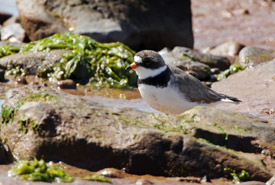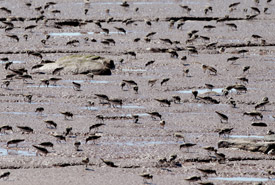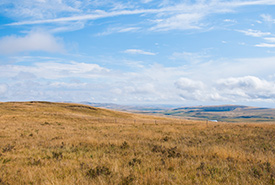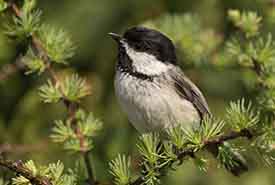Beak to beak: The importance of Bird and Biodiversity Areas and Migratory Bird Sanctuaries

Semipalmated plover, Johnson's Mills, NB (Photo by Mike Dembeck)
Protecting land is critical to the survival of Canada’s natural world. With approximately 80,000 known plant and animal species, many of which are in decline, it is no wonder that the protection of wildlife habitat has never been more important than now.
In response to the rapid decline of bird species on a global level, designated areas have been established around the world to enhance the protection of these habitats. Without habitat in which to breed, rest and nest, birds would disappear entirely. This is where Important Bird and Biodiversity Area (IBA) and Migratory Bird Sanctuary (MBS) designations come into play. But what’s the difference between the two, and how are they helping to protect birds?
Important Bird and Biodiversity Areas
Important Bird and Biodiversity Areas (IBAs) are areas of land or water set aside by BirdLife International. They support habitat for birds that are at-risk or have large seasonal concentrations. These areas are diverse in size and habitat type, ranging from a small wetland section to a vast forest. IBAs do not have legal status, but are intended to highlight the importance of certain areas for birds and to encourage conservation efforts.

Johnson's Mills, NB (Photo by Mike Dembeck)
IBAs have been designated around the world using standard criteria, such as population trends, range and species conservation status. For example, if a bird species regularly appears in large groups within an area for breeding, wintering or migration, the area could qualify as an IBA. IBAs are categorized based on the scale of their importance. Some are nationally important because they support federal species at risk. Others are important from a continental and global level, because they support a large portion of a species’ population. By protecting resting and nesting habitat for birds, these areas help sustain migratory bird populations.

Foothills fescue grasslands, AB (Photo by Leta Pezderic)
At the Nature Conservancy of Canada (NCC), we use the locations of IBAs to help identify key areas for conservation. To date, NCC has helped conserve 64 areas across Canada that include or are adjacent to IBAs, such as the Prairie Grassland Conservation Region in Alberta, Ontario’s Southern Norfolk Sand Plain Natural Area and Johnson’s Mills Shorebird Reserve and Interpretive Centre in New Brunswick.
Migratory Bird Sanctuaries
While International Bird and Biodiversity Areas are a global initiative and have designated areas around the world, Migratory Bird Sanctuaries occur only in Canada and are managed by the Canadian Wildlife Service. As part of the Migratory Birds Conservation Act, the first MBS was officially designated in Quebec in 1919. Before that, in 1887, the Government of Canada established the first protected area with the purpose of protecting land for migratory birds. Receiving official designation in 1921, Last Mountain Lake in southern Saskatchewan was the first MBS established in North America and to this day remains a haven for migratory and breeding birds.

Black-capped chickadee at small wetland adjacent to NCC beach in Grand Manan (Photo by Nick Hawkins)
Similar to the way IBA designations are established, MBS designations are recognized in areas that are important for bird conservation, such as for seasonal congregations and rare species. Another reason an MBS may be established is if bird populations become vulnerable to area-specific threats, including hunting or development in habitats where nesting, moulting, wintering or staging occur. These areas help protect migratory birds by conserving their habitat and making it illegal to hunt or disturb them.
There are currently 92 Migratory Bird Sanctuaries across Canada, 19 of which are located on or within five kilometres of NCC-conserved properties. NCC is working to protect habitat for migratory birds on the island of Grand Manan, where the 1,070-acre (433-hectare) Grand Manan Migratory Bird Sanctuary is located. By conserving this area, NCC is protecting vital habitat for species, such as bufflehead, sanderling and green-winged teal.



